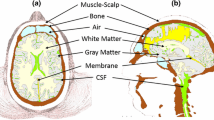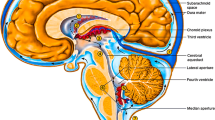Abstract
Spinal arachnoiditis comprises fibrous scarring of the subarachnoid space, following spinal trauma or inflammation, and is often associated with syringomyelia. We hypothesised that cord-to-dura attachments could cause transient tensile cord radial stress, as pressure waves propagate. This was tested in a fluid–structure interaction model, simulating three types of cord tethering, with ‘arachnoiditis’ confined to a short mid-section of the cord. The annular system was excited abdominally with a short transient, and the resulting Young and Lamb waves and reflections were analysed. Radial mid-section tethering was less significant than axial tethering, which gave rise to tensile radial stress locally when the cord was not fixed cranially. Simulated as inextensible string connections to the dura, arachnoiditis caused both localised tensile radial stress and localised low pressure in the cord as the transient passed. The extent of these effects was sensitive to the relative stiffness of the dura and cord. Tensile radial stress may create a syrinx in previously normal cord tissue, and transiently lowered pressure may draw in interstitial fluid, causing the syrinx to enlarge if fluid exit is inhibited. The suggested mechanism could also explain the juxtaposition of syrinxes to regions of arachnoiditis.




Similar content being viewed by others
Notes
The concept of pressure here requires careful definition, since strictly there are only directed stresses in an elastic solid. Pressure is calculated as minus the average of the mutually orthogonal normal stresses. If the solids were microporous, with a fluid content component (as it is in reality in the case of cord tissue), the fluid would have this pressure.
Further analysis of wave propagation in an infinitely long annular space bounded outside by a rigid conduit and inside by an elastic vessel containing another fluid is given by Cirovic et al. [5], particularly for Young waves. They also analyse a model consisting of two coaxial solid elastic annuli creating three coaxial fluid spaces within a rigid outermost tube.
References
Bertram CD, Brodbelt AR, Stoodley MA (2005) The origins of syringomyelia: Numerical models of fluid/structure interactions in the spinal cord. ASME J Biomech Eng 127:1099–1109
Bilston LE, Thibault LE (1996) The mechanical properties of the human cervical spinal cord in vitro. Ann Biomed Eng 24:67–74
Bilston LE, Fletcher DF, Brodbelt AR, Stoodley MA (2003) Arterial pulsation-driven cerebrospinal fluid motion in the perivascular space: a computational model. Comput Methods Biomech Biomed Eng 6:235–241
Carpenter PW, Berkouk K, Lucey AD (2003) Pressure wave propagation in fluid-filled co-axial elastic tubes, part 2: Mechanisms for the pathogenesis of syringomyelia. ASME J Biomech Eng 125:857–863
Cirovic S, Walsh C, Fraser WD (2002) Wave propagation in a system of coaxial tubes filled with incompressible media: a model of pulse transmission in the intracranial arteries. J Fluids Struct 16:1029–1049
Galford JE, McElhaney JH (1970) A viscoelastic study of scalp, brain, and dura. J Biomech 3:211–221
Greitz D, Ericson K, Flodmark O (1999) Pathogenesis and mechanics of spinal cord cysts—a new hypothesis based on magnetic resonance studies of cerebrospinal fluid dynamics. Int J Neuroradiol 5:61–78
Heiss JD, Patronas N, DeVroom HL, Shawker T, Ennis R, Kammerer W, Eidsath A, Talbot T, Morris J, Eskioglu E, Oldfield EH (1999) Elucidating the pathophysiology of syringomyelia. J Neurosurg 91:553–562
Levine DN (2004) The pathogenesis of syringomyelia associated with lesions at the foramen magnum: a critical review of existing theories and proposal of a new hypothesis. J Neurol Sci 220:3–21
Mazuchowski EL, Thibault LE (2003) Biomechanical properties of the human spinal cord and pia mater. In: ASME summer bioengineering conference, Key Biscayne, Florida, 25–29 June 2003, pp 1205–1206
Ozawa H, Matsumoto T, Ohashi T, Sato M, Kokubun S (2004) Mechanical properties and function of the spinal pia mater. J Neurosurg Spine 1:122–127
Runza M, Pietrabissa R, Mantero S, Albani A, Quaglini V, Contro R (1999) Lumbar dura mater biomechanics: experimental characterization and scanning electron microscopy observations. Anesth Analg 88:1317–1321
Stockman HW (2006) Effect of anatomical fine structure on the flow of cerebrospinal fluid in the spinal subarachnoid space. ASME J Biomech Eng 128:106–114
The visible human project®: U.S. National Library of Medicine. http://www.nlm.nih.gov/research/visible/visible_human.html
Tunturi AR (1977) Elasticity of the spinal cord dura in the dog. J Neurosurg 47:391–396
Tunturi AR (1980) Viscoelasticity of dog spinal cord. Physiol Chem Phys 12:373–378
Wilcox RK, Bilston LE, Barton DC, Hall RM (2003) Mathematical model for the viscoelastic properties of dura mater. J Orthop Sci 8:432–434
Williams B (1976) Cerebrospinal fluid pressure changes in response to coughing. Brain 99:331–346
Author information
Authors and Affiliations
Corresponding author
Additional information
Parts of this work were presented at the 5th World Congress of Biomechanics, Munich, Germany, 29 July–4 August 2006, and at the Conquer Chiari Research Symposium, Chicago, USA, 2 June 2007.
Rights and permissions
About this article
Cite this article
Bertram, C.D., Bilston, L.E. & Stoodley, M.A. Tensile radial stress in the spinal cord related to arachnoiditis or tethering: a numerical model . Med Biol Eng Comput 46, 701–707 (2008). https://doi.org/10.1007/s11517-008-0332-0
Received:
Accepted:
Published:
Issue Date:
DOI: https://doi.org/10.1007/s11517-008-0332-0




